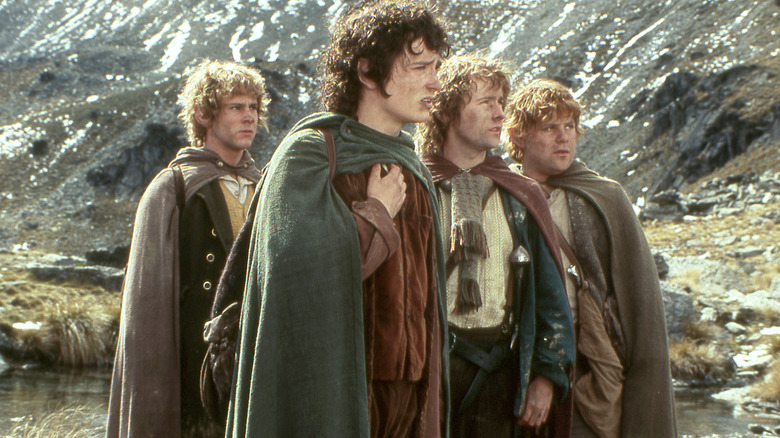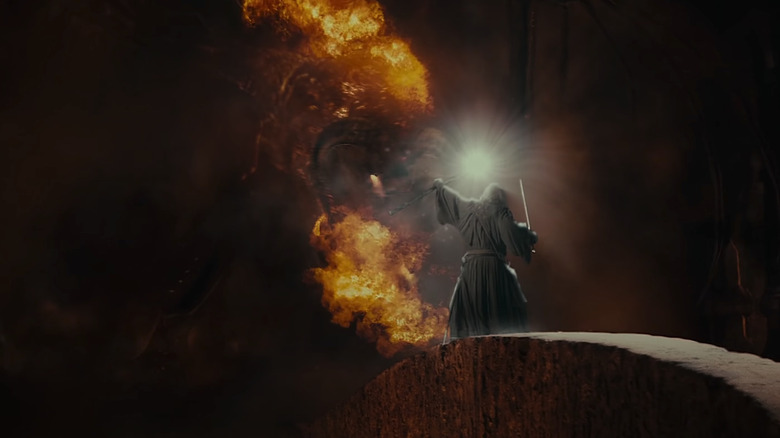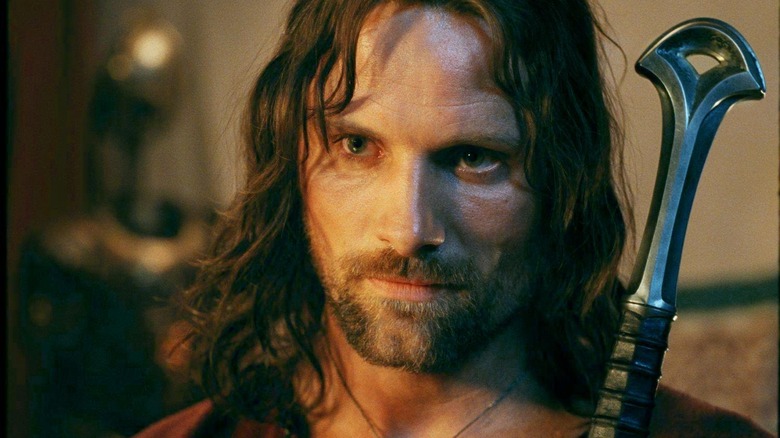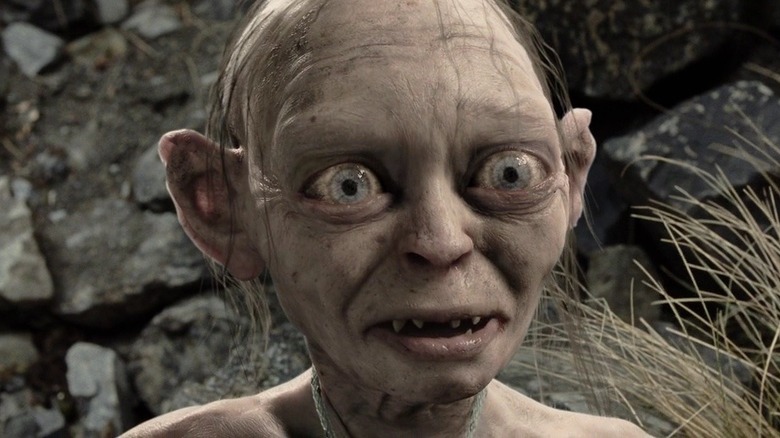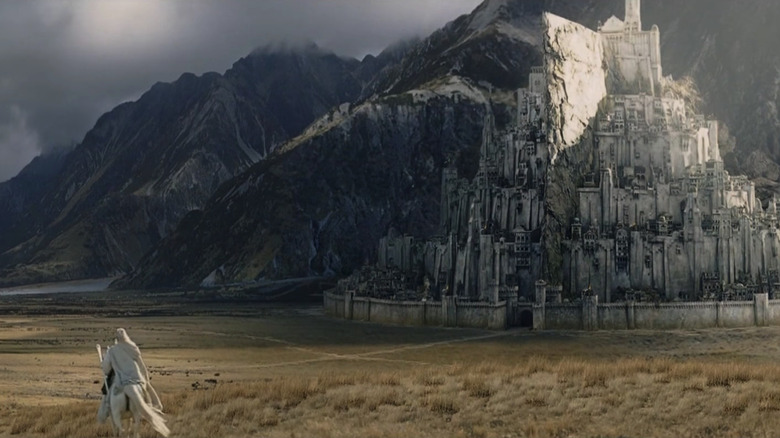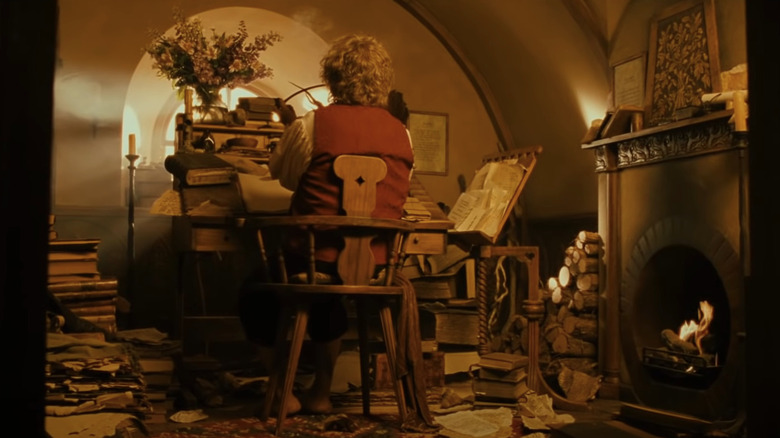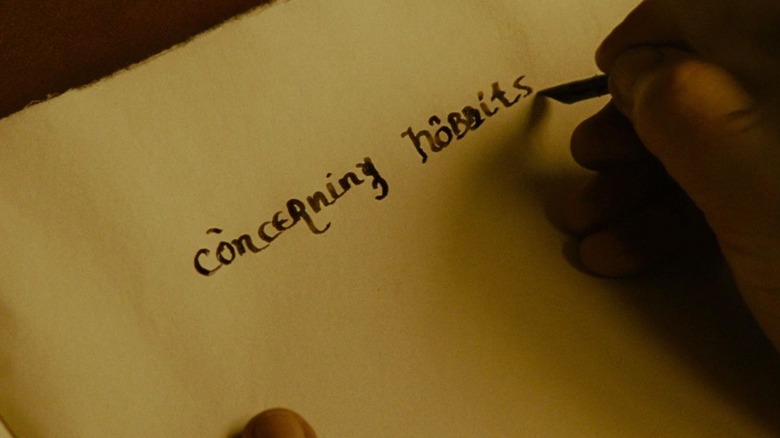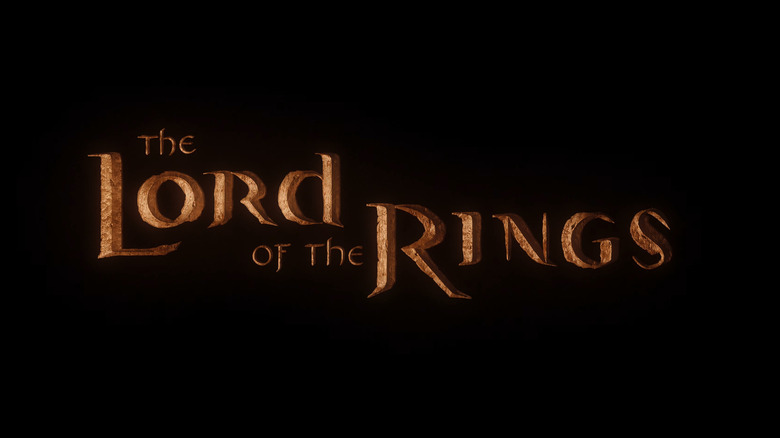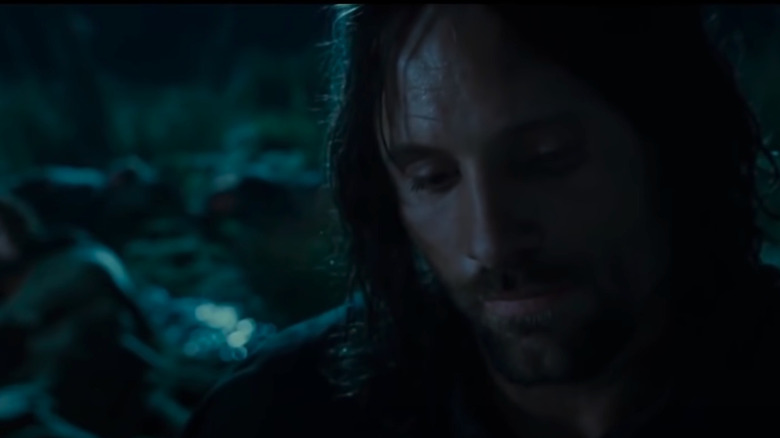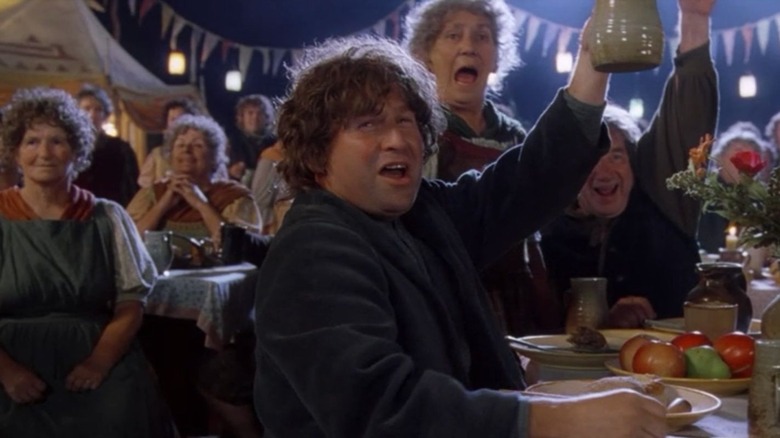How Lord Of The Rings: The Fellowship Of The Ring Changed Movies Forever
It's hard to believe that Peter Jackson's "Lord of the Rings" trilogy has been with us for 20 years. All the way back on December 19, 2001, "The Fellowship of the Ring" officially hit theaters across multiple countries, including the good ol' US of A ... and the world was never the same again (via IMDb). That may sound a bit extreme, but in the context of cinema and entertainment, the statement really does hold water.
The arrival of Jackson's trio of films, which were released over the course of three Decembers from 2001 to 2003, represented a revolutionary shift for both the fantasy genre and Hollywood as a whole. The movies challenged the status quo in so many different areas. They didn't just entertain a small sliver of the public. They engrossed an entire generation of movie-goers and encouraged multiple generations since then to continue to buy into the epic experience that fantasy films can offer.
From setting new production expectations in quality to finally gaining some much-deserved respect from the more pretentious members of the Academy, "The Fellowship of the Ring" marks a watershed moment in movie history. We decided to sit down and ruminate on some of the biggest ways that the film changed the movie experience for the better — both at the turn of the century and in the years since.
The fantasy in The Fellowship of the Ring becomes a blockbuster mainstream
It's hard to believe that there was ever a time when elves, demons, superheroes, and other fantastic subject matter weren't accepted as primary forms of entertainment. And yet, before Peter Jackson tackled his ambitious project, the masses struggled to accept these other-worldly elements as part of the popular film industry.
Sure, they existed. And some areas of fiction, like sci-fi, had a firm foothold in the collective imagination at this point via franchises like "Star Wars" and "Star Trek." But by and large, fantasy stories weren't very popular — at least not in movie form. To be fair, "The Lord of the Rings" books were already well-known favorites, and other literary series like "The Wheel of Time" and "Game of Thrones" were already gaining steam by the time Jackson started filming in the late '90s.
Nevertheless, the movie industry didn't have much to show in the way of classic fantasy adaptations. The actual production capabilities were an admittedly difficult hurdle to overcome. But it doesn't change the fact that Peter Jackson came along at just the right time to turn a fringe film genre into a mainstream entertainment option that could captivate the hearts and minds of fanatical and fair-weather viewers alike.
If you need more proof of its impact, one of the greatest testaments to how much "The Fellowship of the Ring" helped to change the public perception of the fantasy genre took place just before its 20th birthday. In late 2021, the first movie in Jackson's trilogy was officially inducted into the National Film Registry — just two short decades after its release, via CBS News.
CGI isn't everything in fantasy and The Fellowship
There's no denying the fact that "The Fellowship of the Ring" and its two sequels lean heavily on the special effects. From epic sets to individual interactions, there's no doubt that "The Lord of the Rings" made the most of cutting-edge CGI (for the times at least) throughout post-production. And yet, 20 years later, one thing stands out — the CGI wasn't the focal point of the movies. In fact, with a few exceptions like Gollum, it served much more as a complement for many other critical elements.
One of these is the acting. The incredible cast of "The Lord of the Rings" has etched its name in history through the prolific number of top-notch performances that it delivered throughout the trilogy. From household names like Sir Ian McKellen to then-rising stars like Viggo Mortensen, the movies are overloaded with more than their fair share of quality actors.
This doesn't just make for a fun watching experience. At the time, it also demonstrated to the world that quality actors could deliver out-of-this-world performances ... even in stories that are quite literally out of this world.
It's a lesson that has percolated through the film industry ever since. As audiences have used Jackson's films as a benchmark for high-quality fantasy, countless other additions to the genre have tried to reach similar heights. Some have had resounding success. Others have come up short. While we won't point any fingers here, the acting expectations set by "The Lord of the Rings" have continued to impact how audiences have received movies — especially fantasy films — ever since.
But ... CGI is also, still, kinda a big deal in The Lord of the Rings
As much as elements like acting are a critical part of what makes "The Lord of the Rings" successful, it's still difficult to overlook how much CGI impacted the overall experience. From huge armies of Orcs, Men, and Elves, to giant, sprawling landscapes, to a fiery Balrog, there is no doubt that the post-production efforts left an indelible mark on the memories of viewers.
Few computer graphic elements of the Middle-earth masterpiece stand out more than the character of Gollum, as performed and voiced by the great Andy Serkis. Remember, this was coming hot on the heels of "Star Wars: The Phantom Menace" which sported the ridiculed CGI character of Jar Jar Binks. With that experience still smarting in the minds of viewers, the thought of another fully computerized character in a fantasy world sounded like a recipe for disaster. The knowledge that it would be inserted into such a well-produced story made it that much more concerning.
Then Gollum made his formal debut, and the crowds didn't panic. They didn't cringe. In fact, they found the character to be quite fun to watch. After briefly appearing in "The Fellowship of the Ring," Gollum went on to play a bigger part in the next two films (via Screen Rant). He fit in with his surroundings, interacted with others well, and was generally able to melt right into the larger story. The success of Gollum, along with the rest of the expertly inserted CGI, was a historic moment for movies. It marked the dawn of a new era of 21st-century filmmaking — an era where CGI could seamlessly add to (rather than detract from) the movie experience in a meaningful way.
The Fellowship of the Rings launches the era of "big gamble" entertainment
In an article written for the 20th anniversary of "The Fellowship of the Ring," Variety's Tim Gray referred to Peter Jackson's proposed project as "one of film history's greatest gambles" and "one of Hollywood's riskiest projects ever." He broke down things like Jackson's less-than-monumental track record beforehand, and how big of an ask it was for the director to want to adapt Tolkien's writings for the silver screen.
Of course, hindsight is 20/20, and looking back, the decision to greenlight three films at once was a brilliant decision. At the time, rolling the dice on a project of this size and scope was fairly unique. There have obviously always been larger projects that studios are willing to tackle. But committing to multiple movies in a genre that hadn't fully proven its profitability yet was something new.
The results didn't just pay off at the time. It also impacted the way that the film industry approached high-risk, multi-movie projects. This can be seen reflected in countless films and series since then, not the smallest of which include Amazon Studios' incredibly expensive investments in other fantasy projects like "The Wheel of Time" and their luxuriously funded Second Age Middle-earth project — due in September of 2022. While Hollywood has always been willing to take risks, the LOTR trilogy ushered in a new level of boldness. Studios were suddenly more willing to make sizeable investments in "big gamble" projects in the hopes of a Tolkien-sized payout at the other end of the deal.
The Lord of the Rings signals the rise of open-ended storytelling in film
Leaving a story open-ended is a common television storytelling trope. Serialized entertainment requires the need to provide a reason to come back and watch the next episode. For movies, though, the most common format is the three-act narrative. This starts, develops, and completes a story within the bounds of a single movie — even if it's within a larger, multi-part narrative arc. "The Pirates of the Caribbean" franchise is a great example of this. While all of its films flow together in a larger story, each installment serves as its own complete tale as well.
Not so with "The Lord of the Rings." Jackson's project marked one of the first times that a massive, multi-movie ordeal completely disregarded this formulaic form of movie storytelling. Rather than opting to close up each movie as its own distinct unit, the scriptwriters chose to follow the format outlined in the books themselves.
Each movie ends, well, where it ends. They don't exactly follow the books for all three films, but both the first two books and movies leave the story wide open when they come to a close. Then they pick right back up where they left off when the next one starts. Instead of making a trilogy of three distinct parts, this leads to the feeling of a single story presented in three specific installments. While this has become common with countless 21st century projects, planning unresolved endings right from the start of the project was unheard of at the time, especially for a project of this magnitude.
Telling really, really long stories in movies
In the Foreword to "The Fellowship of the Ring" book, Tolkien explains that his primary motivation for the story was "the desire of a tale-teller to try his hand at a really long story that would hold the attention of readers, amuse them, delight them, and at times maybe excite them or deeply move them." When Peter Jackson pitched the idea of turning Tolkien's world into a movie though, it started with a much more restrained vision.
According to Variety, Jackson's "first idea was to do 'The Hobbit' as single film, then if that worked, do two 'Lord of the Rings' movies." Jackson sold Harvey Weinstein on the idea, only to eventually have the since-disgraced movie kingpin try to shrink the project into a single movie. This led to the exec giving Jackson a short window of time to find a studio willing to take the idea on as a multi-film deal — an event that Elijah Wood later reported led to a Weinstein-inspired Orc mask once the film got off the ground (per Deadline).
In spite of being in a tight spot, Jackson sold New Line Films chairman Bob Shaye on the idea — so well, in fact, that Shaye suggested bumping the number up to three films. With three full movies greenlit by New Line, Jackson had an opportunity to tell a really long story in Tolkienian fashion that could captivate audiences from beginning to end. The fact that he succeeded with this goal set the tone for the era of lengthy storytelling that has followed ever since.
Truly creating immersive secondary belief in The Lord of the Rings
One of the hallmarks of good storytelling is the ability to make the reader believe that they're in the world itself. For Tolkien, perfecting this went beyond the common phrase "suspension of disbelief." The author insisted that good storytelling involves truly drawing an audience into the experience. In his essay "On Fairy-Stories," he states that if a creator builds a world that genuinely does this, "You therefore believe it, while you are, as it were, inside. The moment disbelief arises, the spell is broken; the magic, or rather art, has failed."
Writing for InsideHook, Alex Lauer points out how well Jackson's adaptations mirror this desire to create an immersive secondary level of belief within a fantasy world. Lauer notes how the first 10 minutes of the film are crucial to accomplishing this. From Cate Blanchett's narration to the steady, unrushed pace, the introduction carefully sets the stage, inviting viewers into the world that follows. Other adaptations like "The Wheel of Time" have struggled to introduce their worlds in a truly immersive manner.
In contrast, Lauer references the introductory sequence to "Game of Thrones" as an example of a series that clearly learned from the precedent set by Jackson and his team. Whether it's done successfully or not, the ability to truly draw audiences into a state of secondary belief is a hallmark achievement of "The Fellowship of the Ring" and its subsequent films that the fantasy genre — and movies in general — have been chasing ever since.
Peter Jackson popularizes the almighty extended cut
Extended editions of films are always a fascinating novelty. They whip up rabid fan bases into a frenzy and shed a bit more light on a film's original storytelling direction, intent, length, and so on. The release of extended cuts has become commonplace in recent years. The poster child of this new obsession can be found in Zack Snyder's $70 million reshoots of "Justice League."
Suffice it to say that going back and tampering with the theatrical original isn't anything unusual. While "The Lord of the Rings" wasn't the first film to do this, it certainly set the tone for it to become normal behavior. Peter Jackson went back and released enormously long extended editions for each movie — all of which have become far more popular than the originals for most diehard fans who are willing to sit through nearly half a day of movie-watching when they're viewed back to back.
The funny thing is, Jackson personally doesn't even prefer the extended editions, per IGN. He thinks they slow down the pacing and muck up the momentum, which is a valid point. Nevertheless, he created each one as a labor of love for fans who wanted to see more. And the job of creating these much-longer versions hasn't just been justified through their reception from "Lord of the Rings" fans, who received them as if they were new films. Their success also led to a general expectation of extended, director-led, non-theatrical cuts for any larger film project in the years since.
Getting the attention of the Academy
It's impossible to point out how "The Lord of the Rings" trilogy impacted the movie world without bringing up its off-screen success, particularly at the Academy Awards. In spite of its looked-down-upon fantastical focus, the quality and effort that Jackson and company invested in their trio of films exhibited such a high degree of professionalism that it was impossible for the Oscars to ignore them.
On the contrary — right out of the gate, "The Fellowship of the Ring" started winning big at the film industry's most prestigious ceremony. Along with a string of other nominations, the first film walked away with four awards, covering makeup, music, visual effects, and cinematography (via IMDb). "The Two Towers" took a step back, although it still brought home a respectable pair of Oscars for editing and visual effects. And then, of course, "The Return of the King" stole the whole show by making a clean sweep of all 11 of its nominations including Best Picture, according to IMDb.
The resounding impact of this acknowledgment from the elite pinnacle of the film community has reverberated throughout the movie industry ever since. The Awards have expanded to acknowledge an ever-increasing number of genres and projects. And while this can't all be attributed to the success of Peter Jackson's films, the magnitude of their success at the Oscars stands as a definitive moment that broadened the Oscar-related scope and hope of production crews, no matter what project they might be working on at any given moment.
